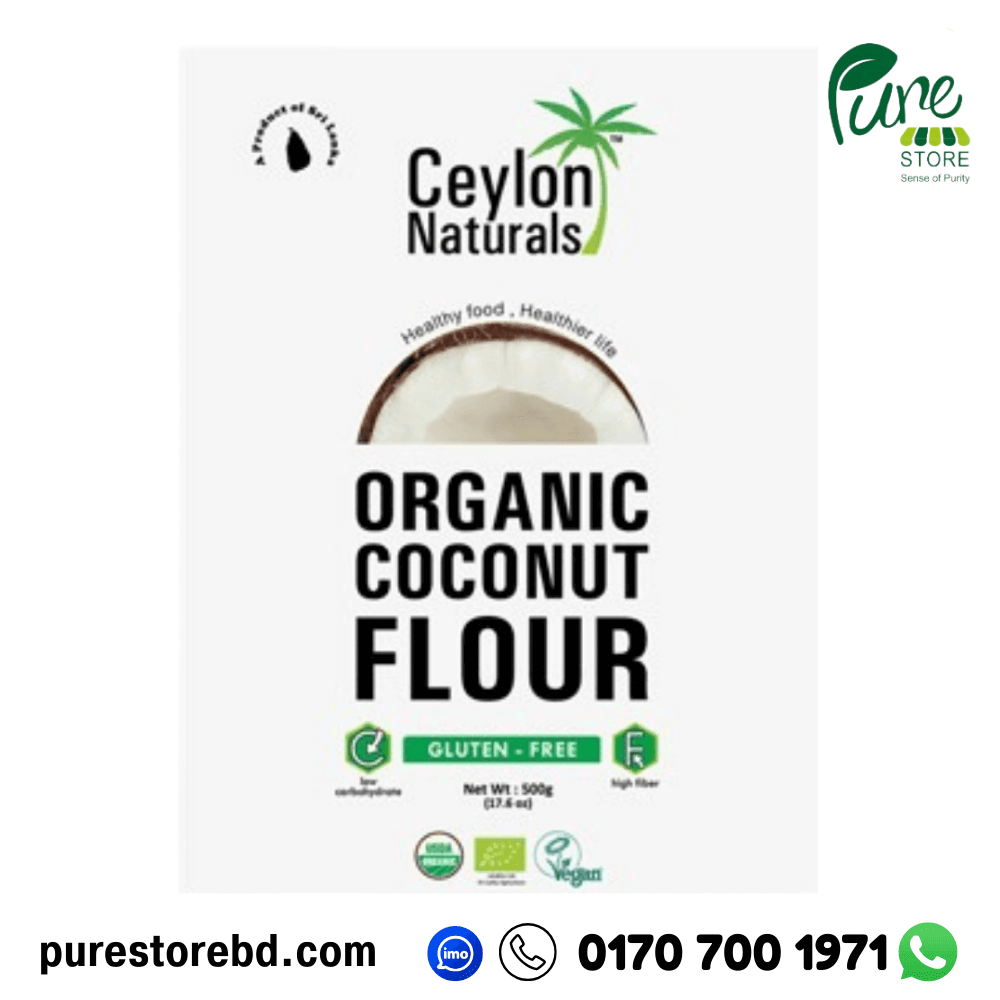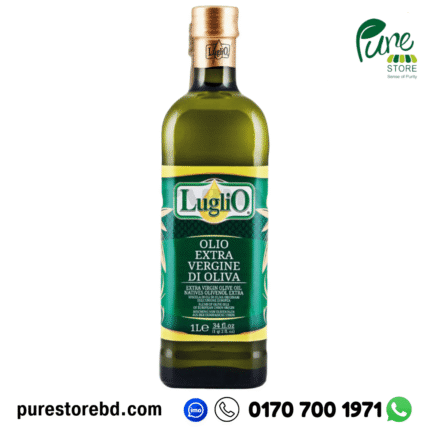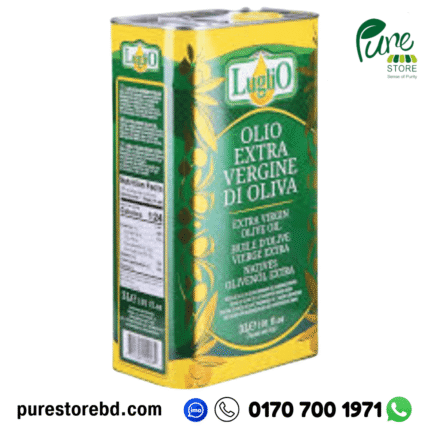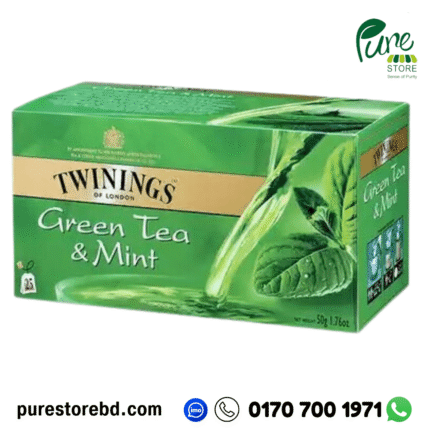অর্গানিক কোকোনাট ময়দা I Organic Coconut Flour I 500 gm
৳ 1,150.0
Coconut flour is a gluten-free flour made solely from coconuts. It’s high in fiber and is a good source of protein. Adding it to your diet may promote stable blood sugar, good digestion, and heart health. It may also support a healthy body weight when consumed as part of a nutritious, balanced diet.
Product details of Ceylon Nature Organic Coconut Flour 500gm
Product Type: Organic Coconut Flour
Brand: Ceylon Naturals
Weight: 500gm
100% Original
Origin of Srilanka
বিশেষ দ্রষ্টব্য : পণ্যের মান নিয়ে কোন অভিযোগ থাকলে পণ্য পরিবর্তন অথবা মূল্য ফেরত যোগ্য।আপনার যে কোন পরামর্শ বা উপদেশ সাদরে গ্রহন করা হবে। যা নিরাপদ খাদ্য আন্দোলনে সহায়ক ভূমিকা রাখবে।
⊕ ⇒ CEYLON ORGANIC COCONUT FLOUR 500gm BDT1150 /-
অর্ডার কনফার্ম করার জন্য কল করুন ::
মোবাইল / হোয়াটস এপপ্স / ইমো # 01707001971
—————————————————————————————



১.১ নাম #
১.২.ঠিকানা (বিস্তারিত) # বাড়ী নম্বর # কত তলা/ফ্লাট নম্বর # , রোড নম্বর # ,থানার নাম #
( লোকেশনের কাছাকাছি পরিচিত স্থান/বাজার/স্কুলের নাম)
২.১ আপনার মোবাইল নম্বর (সম্ভভ হলে )
২.২ ২য় কন্টাক্ট পারসনের নাম ও মোবাইল নম্বর
৩. প্রোডাক্ট এর নাম ,কোড অথবা ছবি ও পরিমান
[ মেসেজ পাঠানোর পর আমরা আপনার সাথে যোগাযোগ করে অর্ডার কনফার্ম করবো ]
=========================================











মোবাইল / হোয়াটস এপপ্স / ইমো # 01707001971
[ সকাল ১০টা থেকে রাত ১০ টার মধ্যে, ফোনে না পেলে এস এম এস দিয়ে রাখুন 0170 700 1971 নম্বরে ]
Out of stock
What is a Coconut Flour
Coconut flour is the white inner flesh of the coconut that has been dried and processed into the meal. While the coconut is now grown all over the tropics, the tree originated in India and South Asia. It then migrated around the world, thanks to traders and ocean currents. Today it is one of the most widely used ingredients around the world, ranging from its use as a basic dried coconut to coconut water and coconut milk and oil.
Coconut flour is not flour by any traditional sense of the word, as it has no grains, and is popular with people suffering from nut allergies who cannot have alternative flours like almond. Recently, it has become well known once again thanks to the paleo diet, which excludes dairy and grain products, but coconut flesh has long been dried and used in traditional subtropical culinary traditions around the Southern hemisphere.
Coconut Flour Nutrition
According to USDA FoodData Central, a 100g serving of coconut flour (branded), has roughly 400 calories, 13.3 grams of protein, and 20 grams of fat. It also has 20 grams of sugar, 60 grams of carbs, and 33.3 grams of fiber.
Coconut Flour Benefits
Gluten-Free
Coconut flour is naturally gluten-free and has become a favorite of modern consumers who are on gluten-free, dairy-free, or nut-free diets. Gluten is a protein found in wheat, barley, and rye products. 1 in 100 people worldwide is affected by gluten intolerance, or in serious cases, full-blown Celiac disease, where gluten digestion damages the small intestine. Even if you do not suffer when ingesting gluten, there is plenty of evidence to suggest that avoiding gluten in your diet may be beneficial. Not only does avoiding gluten help with weight management, but foods with gluten may also encourage inflammation and block nutrient absorption
MCTs -Healthy Fats
Coconut has high levels of healthy saturated fats, nutrients that until recently had a negative reputation, while still low in polyunsaturated fats. However, recent medical research has recognized that not all fat is bad fat, and fat itself performs a number of very important functions in the body. Most of the fat in coconut flour consists of medium-chain triglycerides, [3] which are digested easily in your system, and have antiviral, antimicrobial and antifungal properties. They may also boost your metabolism. Lauric acid is a fatty acid found in foods with high saturated fat content. Lauric acid helps boost cardiovascular health, may prevent acne outbreaks, and inhibits [4] the growth of bacteria and viruses in the body. It also contributes to healthy skin and a strong immune system.
High Fiber and Protein
Coconut flour has the highest fiber content of commercially available flours, with 5 grams of this indigestible carbohydrate per tablespoon. Coconut flour is actually made up of 60% [5] fiber; 56% insoluble fiber and 4% soluble. High-fiber diets are not only good for digestive health and blood pressure, but they also lower “bad” LDL cholesterol levels and help manage weight loss by keeping you fuller for longer. Coconut flour also contains far more protein than whole wheat flour. Protein is an important building block of bones, muscles, and tissue.
Mineral Availability
Most grain flour has a compound called phytic acid in it. Phytic acid binds to minerals and stops them from being absorbed properly by your body. To avoid this, grains are usually soaked before they are used. However, coconut flour does not have any phytic acid and therefore does not interfere in mineral absorption.
Low Glycemic Index
Because of its high levels of insoluble fiber, coconut flour also has a very low glycemic index. Adding coconut flour to baking can actually help prevent blood sugar spikes, and maybe a great diet addition for anyone managing or doing their best to prevent the onset of diabetes. According to a study published by the Cambridge University Press, conducted by Trinidad P. Trinidad et al., there is a strong negative correlation between coconut flour fiber levels and glycemic load on the body.
Substituting Coconut Flour in Recipes
When you begin experimenting with new flour, it is important to remember that it will not behave the same as wheat flour.
Coconut flour is not a grain, so it is softer and much more absorbent than wheat flour.
It cannot be substituted in a 1:1 ratio. Instead, use ⅓ cup coconut flour for every 1 cup of wheat flour.
Coconut flour also requires a lot of moisture in baking, so at least six eggs and one cup liquid is recommended for every one cup of coconut flour used.
Using established baking recipes, or gluten-free flour blends that combine coconut with other flours is much easier.
Coconut flour also tends to be clumpy and should be blended well with all dry ingredients before adding liquid.
When using coconut flour in other applications, like frying, it can be treated the same as regular flour for dredging. It can also be used to make gravies and sauces, but start with less and add more as needed.
Word of Caution: Coconut flour is generally safe in any amount. People with coconut allergies should avoid using coconut flour. Coconut flour does contain saturated fats and may increase cholesterol in some people if used too often. As with any addition to your diet, use this flour in moderation.
MAECENAS IACULIS
Vestibulum curae torquent diam diam commodo parturient penatibus nunc dui adipiscing convallis bulum parturient suspendisse parturient a.Parturient in parturient scelerisque nibh lectus quam a natoque adipiscing a vestibulum hendrerit et pharetra fames nunc natoque dui.
ADIPISCING CONVALLIS BULUM
- Vestibulum penatibus nunc dui adipiscing convallis bulum parturient suspendisse.
- Abitur parturient praesent lectus quam a natoque adipiscing a vestibulum hendre.
- Diam parturient dictumst parturient scelerisque nibh lectus.
Scelerisque adipiscing bibendum sem vestibulum et in a a a purus lectus faucibus lobortis tincidunt purus lectus nisl class eros.Condimentum a et ullamcorper dictumst mus et tristique elementum nam inceptos hac parturient scelerisque vestibulum amet elit ut volutpat.
Related products
অর্গানিক কোকোনাট ভিনেগার উইথ দি মাদার -ডি নিগ্রিস I ORGANIC COCONUT VINEGAR – DE NIGRIS I 500ml
- Brand: De Nigris
- Made in Italy
- Flavor: Coconut
- Weight: 500ml
বিশেষ দ্রষ্টব্য : পণ্যের মান নিয়ে কোন অভিযোগ থাকলে পণ্য পরিবর্তন অথবা মূল্য ফেরত যোগ্য।আপনার যে কোন পরামর্শ বা উপদেশ সাদরে গ্রহন করা হবে। যা নিরাপদ খাদ্য আন্দোলনে সহায়ক ভূমিকা রাখবে।
- ⊕ ⇒De Nigris Organic কোকোনাট ভিনেগার’এর মূল্য : ৫০০ গ্রাম ১,৪০০/- টাকা
 ঢাকা সিটিতে পণ্য হাতে পেয়ে টাকা পরিশোধ করবেন।
ঢাকা সিটিতে পণ্য হাতে পেয়ে টাকা পরিশোধ করবেন।
 ক্যাশ অন ডেলিভারী Cash on Delivery (COD).
ক্যাশ অন ডেলিভারী Cash on Delivery (COD).
 অর্ডার করার জন্য, আমাদের মোবাইলের ইনবক্সে মেসেজ সেন্ড করুনঃ
১.১ নাম #
১.২.ঠিকানা (বিস্তারিত) # বাড়ী নম্বর # কত তলা/ফ্লাট নম্বর # , রোড নম্বর # ,থানার নাম #
( লোকেশনের কাছাকাছি পরিচিত স্থান/বাজার/স্কুলের নাম)
২.১ আপনার মোবাইল নম্বর (সম্ভভ হলে )
২.২ ২য় কন্টাক্ট পারসনের নাম ও মোবাইল নম্বর
৩. প্রোডাক্ট এর নাম ,কোড অথবা ছবি ও পরিমান
[ মেসেজ পাঠানোর পর আমরা আপনার সাথে যোগাযোগ করে অর্ডার কনফার্ম করবো ]
=========================================
অর্ডার করার জন্য, আমাদের মোবাইলের ইনবক্সে মেসেজ সেন্ড করুনঃ
১.১ নাম #
১.২.ঠিকানা (বিস্তারিত) # বাড়ী নম্বর # কত তলা/ফ্লাট নম্বর # , রোড নম্বর # ,থানার নাম #
( লোকেশনের কাছাকাছি পরিচিত স্থান/বাজার/স্কুলের নাম)
২.১ আপনার মোবাইল নম্বর (সম্ভভ হলে )
২.২ ২য় কন্টাক্ট পারসনের নাম ও মোবাইল নম্বর
৩. প্রোডাক্ট এর নাম ,কোড অথবা ছবি ও পরিমান
[ মেসেজ পাঠানোর পর আমরা আপনার সাথে যোগাযোগ করে অর্ডার কনফার্ম করবো ]
=========================================
 ঢাকা সিটিতে ডেলিভারি চার্জ নুন্যতম ৮০ টাকা ( অতিরিক্ত ওজনে প্রতি কেজির জন্য ১৫ টাকা হারে ডেলিভারি চার্জ বৃদ্ধি পাবে)।
ঢাকা সিটিতে ডেলিভারি চার্জ নুন্যতম ৮০ টাকা ( অতিরিক্ত ওজনে প্রতি কেজির জন্য ১৫ টাকা হারে ডেলিভারি চার্জ বৃদ্ধি পাবে)।
 ঢাকা সিটির বাইরে কুরিয়ার থেকে ডেলিভারি চার্জ ১২০ টাকা ( অতিরিক্ত ওজনে ডেলিভারি চার্জ বৃদ্ধি পাবে )।
ঢাকা সিটির বাইরে কুরিয়ার থেকে ডেলিভারি চার্জ ১২০ টাকা ( অতিরিক্ত ওজনে ডেলিভারি চার্জ বৃদ্ধি পাবে )।
 ঢাকা সিটির বাইরে জেলা বা উপজেলায় হোম ডেলিভারি চার্জ ১৫০ টাকা ( অতিরিক্ত ওজনে প্রতি কেজির জন্য ৩০ টাকা হারে ডেলিভারি চার্জ বৃদ্ধি পাবে)।
ঢাকা সিটির বাইরে জেলা বা উপজেলায় হোম ডেলিভারি চার্জ ১৫০ টাকা ( অতিরিক্ত ওজনে প্রতি কেজির জন্য ৩০ টাকা হারে ডেলিভারি চার্জ বৃদ্ধি পাবে)।
 ঢাকা সিটির বাইরে থেকে অর্ডারটি নিশ্চিত করতে পণ্যের সম্পুর্ন মুল্য
ঢাকা সিটির বাইরে থেকে অর্ডারটি নিশ্চিত করতে পণ্যের সম্পুর্ন মুল্য  এডভান্স প্রযোজ্য বিকাশ, নগদ ও রকেট অথবা ব্যাংকের মাধ্যমে। ( COD তে ক্যাশ কালেকশনে ১% চার্জ দিতে হবে । বিকাশ, নগদ ও রকেট চার্জ প্রযোজ্য)
এডভান্স প্রযোজ্য বিকাশ, নগদ ও রকেট অথবা ব্যাংকের মাধ্যমে। ( COD তে ক্যাশ কালেকশনে ১% চার্জ দিতে হবে । বিকাশ, নগদ ও রকেট চার্জ প্রযোজ্য)
 Bkash : 0170 700 1971 ( Personal )
Bkash : 0170 700 1971 ( Personal )
 Nagad : 0170 700 1971 ( Personal )
Nagad : 0170 700 1971 ( Personal )
 Rocket : 0170 700 19718 ( Personal )
Rocket : 0170 700 19718 ( Personal )
 DUTCH BANGLA BANK
DUTCH BANGLA BANK
 AC NAME # MD ABDUR ROUF, SAVINGS AC # 2361 5168 939
AC NAME # MD ABDUR ROUF, SAVINGS AC # 2361 5168 939
 মোবাইলে অর্ডার দিতে কল করুন ::
মোবাইলে অর্ডার দিতে কল করুন ::কোল্ড প্রেস নারকেলের তেল I Cold Process Coconut Oil I 500 ML
বিশেষ দ্রষ্টব্য : পণ্যের মান নিয়ে কোন অভিযোগ থাকলে পণ্য পরিবর্তন অথবা মূল্য ফেরত যোগ্য।আপনার যে কোন পরামর্%E
Tri Flora Natural & Medicinal Honey I ট্রাই ফ্লোরা ন্যাচারাল ও মেডিসিনাল মধু I 730 gm
বিশেষ দ্রষ্টব্য : পণ্যের মান নিয়ে কোন অভিযোগ থাকলে পণ্য পরিবর্তন অথবা মূল্য ফেরত যোগ্য।আপনার যে কোন পরামর্শ বা উপদেশ সাদরে গ্রহন করা হবে। যা নিরাপদ খাদ্য আন্দোলনে সহায়ক ভূমিকা রাখবে।⊕ ⇒ ট্রাই ফ্লোরা ন্যাচারাল ও মেডিসিনাল মধু’এর মূল্য : ৭৩০ গ্রাম ২,১৫০/- টাকা অর্ডার কনফার্ম করার জন্য কল করুন ::
 ঢাকা সিটিতে পণ্য হাতে পেয়ে টাকা পরিশোধ করবেন।
ঢাকা সিটিতে পণ্য হাতে পেয়ে টাকা পরিশোধ করবেন।
 ক্যাশ অন ডেলিভারী Cash on Delivery (COD).
ক্যাশ অন ডেলিভারী Cash on Delivery (COD).
 অর্ডার করার জন্য, আমাদের মোবাইলের ইনবক্সে মেসেজ সেন্ড করুনঃ
১.১ নাম #
১.২.ঠিকানা (বিস্তারিত) # বাড়ী নম্বর # কত তলা/ফ্লাট নম্বর # , রোড নম্বর # ,থানার নাম #
( লোকেশনের কাছাকাছি পরিচিত স্থান/বাজার/স্কুলের নাম)
২.১ আপনার মোবাইল নম্বর (সম্ভভ হলে )
২.২ ২য় কন্টাক্ট পারসনের নাম ও মোবাইল নম্বর
৩. প্রোডাক্ট এর নাম ,কোড অথবা ছবি ও পরিমান
[ মেসেজ পাঠানোর পর আমরা আপনার সাথে যোগাযোগ করে অর্ডার কনফার্ম করবো ]
=========================================
অর্ডার করার জন্য, আমাদের মোবাইলের ইনবক্সে মেসেজ সেন্ড করুনঃ
১.১ নাম #
১.২.ঠিকানা (বিস্তারিত) # বাড়ী নম্বর # কত তলা/ফ্লাট নম্বর # , রোড নম্বর # ,থানার নাম #
( লোকেশনের কাছাকাছি পরিচিত স্থান/বাজার/স্কুলের নাম)
২.১ আপনার মোবাইল নম্বর (সম্ভভ হলে )
২.২ ২য় কন্টাক্ট পারসনের নাম ও মোবাইল নম্বর
৩. প্রোডাক্ট এর নাম ,কোড অথবা ছবি ও পরিমান
[ মেসেজ পাঠানোর পর আমরা আপনার সাথে যোগাযোগ করে অর্ডার কনফার্ম করবো ]
=========================================
 ঢাকা সিটিতে ডেলিভারি চার্জ নুন্যতম ৮০ টাকা ( অতিরিক্ত ওজনে প্রতি কেজির জন্য ১৫ টাকা হারে ডেলিভারি চার্জ বৃদ্ধি পাবে)।
ঢাকা সিটিতে ডেলিভারি চার্জ নুন্যতম ৮০ টাকা ( অতিরিক্ত ওজনে প্রতি কেজির জন্য ১৫ টাকা হারে ডেলিভারি চার্জ বৃদ্ধি পাবে)।
 ঢাকা সিটির বাইরে কুরিয়ার থেকে ডেলিভারি চার্জ ১২০ টাকা ( অতিরিক্ত ওজনে ডেলিভারি চার্জ বৃদ্ধি পাবে )।
ঢাকা সিটির বাইরে কুরিয়ার থেকে ডেলিভারি চার্জ ১২০ টাকা ( অতিরিক্ত ওজনে ডেলিভারি চার্জ বৃদ্ধি পাবে )।
 ঢাকা সিটির বাইরে জেলা বা উপজেলায় হোম ডেলিভারি চার্জ ১৫০ টাকা ( অতিরিক্ত ওজনে প্রতি কেজির জন্য ৩০ টাকা হারে ডেলিভারি চার্জ বৃদ্ধি পাবে)।
ঢাকা সিটির বাইরে জেলা বা উপজেলায় হোম ডেলিভারি চার্জ ১৫০ টাকা ( অতিরিক্ত ওজনে প্রতি কেজির জন্য ৩০ টাকা হারে ডেলিভারি চার্জ বৃদ্ধি পাবে)।
 ঢাকা সিটির বাইরে থেকে অর্ডারটি নিশ্চিত করতে পণ্যের সম্পুর্ন মুল্য
ঢাকা সিটির বাইরে থেকে অর্ডারটি নিশ্চিত করতে পণ্যের সম্পুর্ন মুল্য  এডভান্স প্রযোজ্য বিকাশ, নগদ ও রকেট অথবা ব্যাংকের মাধ্যমে। ( COD তে ক্যাশ কালেকশনে ১% চার্জ দিতে হবে । বিকাশ, নগদ ও রকেট চার্জ প্রযোজ্য)
এডভান্স প্রযোজ্য বিকাশ, নগদ ও রকেট অথবা ব্যাংকের মাধ্যমে। ( COD তে ক্যাশ কালেকশনে ১% চার্জ দিতে হবে । বিকাশ, নগদ ও রকেট চার্জ প্রযোজ্য)
 Bkash : 0170 700 1971 ( Personal )
Bkash : 0170 700 1971 ( Personal )
 Nagad : 0170 700 1971 ( Personal )
Nagad : 0170 700 1971 ( Personal )
 Rocket : 0170 700 19718 ( Personal )
Rocket : 0170 700 19718 ( Personal )
 DUTCH BANGLA BANK
DUTCH BANGLA BANK
 AC NAME # MD ABDUR ROUF, SAVINGS AC # 2361 5168 939
AC NAME # MD ABDUR ROUF, SAVINGS AC # 2361 5168 939
 মোবাইলে অর্ডার দিতে কল করুন ::
মোবাইলে অর্ডার দিতে কল করুন ::লুগলিও এক্সট্রা ভার্জিন অলিভ অয়েল I Luglio Extra Virgin Olive Oil I 1000ml
বিশেষ দ্রষ্টব্য : পণ্যের মান নিয়ে কোন অভিযোগ থাকলে পণ্য পরিবর্তন অথবা মূল্য ফেরত যোগ্য।আপনার যে কোন পরামর্শ বা উপদেশ সাদরে গ্রহন করা হবে। যা নিরাপদ খাদ্য আন্দোলনে সহায়ক ভূমিকা রাখবে।অর্ডার কনফার্ম করার জন্য কল করুন ::
 ঢাকা সিটিতে পণ্য হাতে পেয়ে টাকা পরিশোধ করবেন।
ঢাকা সিটিতে পণ্য হাতে পেয়ে টাকা পরিশোধ করবেন।
 ক্যাশ অন ডেলিভারী Cash on Delivery (COD).
ক্যাশ অন ডেলিভারী Cash on Delivery (COD).
 অর্ডার করার জন্য, আমাদের মোবাইলের ইনবক্সে মেসেজ সেন্ড করুনঃ
১.১ নাম #
১.২.ঠিকানা (বিস্তারিত) # বাড়ী নম্বর # কত তলা/ফ্লাট নম্বর # , রোড নম্বর # ,থানার নাম #
( লোকেশনের কাছাকাছি পরিচিত স্থান/বাজার/স্কুলের নাম)
২.১ আপনার মোবাইল নম্বর (সম্ভভ হলে )
২.২ ২য় কন্টাক্ট পারসনের নাম ও মোবাইল নম্বর
৩. প্রোডাক্ট এর নাম ,কোড অথবা ছবি ও পরিমান
[ মেসেজ পাঠানোর পর আমরা আপনার সাথে যোগাযোগ করে অর্ডার কনফার্ম করবো ]
=========================================
অর্ডার করার জন্য, আমাদের মোবাইলের ইনবক্সে মেসেজ সেন্ড করুনঃ
১.১ নাম #
১.২.ঠিকানা (বিস্তারিত) # বাড়ী নম্বর # কত তলা/ফ্লাট নম্বর # , রোড নম্বর # ,থানার নাম #
( লোকেশনের কাছাকাছি পরিচিত স্থান/বাজার/স্কুলের নাম)
২.১ আপনার মোবাইল নম্বর (সম্ভভ হলে )
২.২ ২য় কন্টাক্ট পারসনের নাম ও মোবাইল নম্বর
৩. প্রোডাক্ট এর নাম ,কোড অথবা ছবি ও পরিমান
[ মেসেজ পাঠানোর পর আমরা আপনার সাথে যোগাযোগ করে অর্ডার কনফার্ম করবো ]
=========================================
 ঢাকা সিটিতে ডেলিভারি চার্জ নুন্যতম ৮০ টাকা ( অতিরিক্ত ওজনে প্রতি কেজির জন্য ১৫ টাকা হারে ডেলিভারি চার্জ বৃদ্ধি পাবে)।
ঢাকা সিটিতে ডেলিভারি চার্জ নুন্যতম ৮০ টাকা ( অতিরিক্ত ওজনে প্রতি কেজির জন্য ১৫ টাকা হারে ডেলিভারি চার্জ বৃদ্ধি পাবে)।
 ঢাকা সিটির বাইরে কুরিয়ার থেকে ডেলিভারি চার্জ ১২০ টাকা ( অতিরিক্ত ওজনে ডেলিভারি চার্জ বৃদ্ধি পাবে )।
ঢাকা সিটির বাইরে কুরিয়ার থেকে ডেলিভারি চার্জ ১২০ টাকা ( অতিরিক্ত ওজনে ডেলিভারি চার্জ বৃদ্ধি পাবে )।
 ঢাকা সিটির বাইরে জেলা বা উপজেলায় হোম ডেলিভারি চার্জ ১৫০ টাকা ( অতিরিক্ত ওজনে প্রতি কেজির জন্য ৩০ টাকা হারে ডেলিভারি চার্জ বৃদ্ধি পাবে)।
ঢাকা সিটির বাইরে জেলা বা উপজেলায় হোম ডেলিভারি চার্জ ১৫০ টাকা ( অতিরিক্ত ওজনে প্রতি কেজির জন্য ৩০ টাকা হারে ডেলিভারি চার্জ বৃদ্ধি পাবে)।
 ঢাকা সিটির বাইরে থেকে অর্ডারটি নিশ্চিত করতে পণ্যের সম্পুর্ন মুল্য
ঢাকা সিটির বাইরে থেকে অর্ডারটি নিশ্চিত করতে পণ্যের সম্পুর্ন মুল্য  এডভান্স প্রযোজ্য বিকাশ, নগদ ও রকেট অথবা ব্যাংকের মাধ্যমে। ( COD তে ক্যাশ কালেকশনে ১% চার্জ দিতে হবে । বিকাশ, নগদ ও রকেট চার্জ প্রযোজ্য)
এডভান্স প্রযোজ্য বিকাশ, নগদ ও রকেট অথবা ব্যাংকের মাধ্যমে। ( COD তে ক্যাশ কালেকশনে ১% চার্জ দিতে হবে । বিকাশ, নগদ ও রকেট চার্জ প্রযোজ্য)
 Bkash : 0170 700 1971 ( Personal )
Bkash : 0170 700 1971 ( Personal )
 Nagad : 0170 700 1971 ( Personal )
Nagad : 0170 700 1971 ( Personal )
 Rocket : 0170 700 19718 ( Personal )
Rocket : 0170 700 19718 ( Personal )
 DUTCH BANGLA BANK
DUTCH BANGLA BANK
 AC NAME # MD ABDUR ROUF, SAVINGS AC # 2361 5168 939
AC NAME # MD ABDUR ROUF, SAVINGS AC # 2361 5168 939
 মোবাইলে অর্ডার দিতে কল করুন ::
মোবাইলে অর্ডার দিতে কল করুন ::এক্সট্রা ভার্জিন অলিভ অয়েল-লুগলিও I Extra Virgin Olive Oil -Luglio I 5 Liter
বিশেষ দ্রষ্টব্য : পণ্যের মান নিয়ে কোন অভিযোগ থাকলে পণ্য পরিবর্তন অথবা মূল্য ফেরত যোগ্য।আপনার যে কোন পরামর্শ বা উপদেশ সাদরে গ্রহন করা হবে। যা নিরাপদ খাদ্য আন্দোলনে সহায়ক ভূমিকা রাখবে।
- লুগলিও এক্সট্রা ভার্জিন অলিভ অয়েল ৫ লিঃ মূল্য : ৪,৪০০/- টাকা
- লুগলিও এক্সট্রা ভার্জিন অলিভ অয়েল ১০০০ মিঃলিঃ মূল্য : ১০৫০/- টাকা
- লুগলিও এক্সট্রা ভার্জিন অলিভ অয়েল ৫০০ মিঃলিঃ মূল্য : ৬০০/- টাকা
 ঢাকা সিটিতে পণ্য হাতে পেয়ে টাকা পরিশোধ করবেন।
ঢাকা সিটিতে পণ্য হাতে পেয়ে টাকা পরিশোধ করবেন।
 ক্যাশ অন ডেলিভারী Cash on Delivery (COD).
ক্যাশ অন ডেলিভারী Cash on Delivery (COD).
 অর্ডার করার জন্য, আমাদের মোবাইলের ইনবক্সে মেসেজ সেন্ড করুনঃ
১.১ নাম #
১.২.ঠিকানা (বিস্তারিত) # বাড়ী নম্বর # কত তলা/ফ্লাট নম্বর # , রোড নম্বর # ,থানার নাম #
( লোকেশনের কাছাকাছি পরিচিত স্থান/বাজার/স্কুলের নাম)
২.১ আপনার মোবাইল নম্বর (সম্ভভ হলে )
২.২ ২য় কন্টাক্ট পারসনের নাম ও মোবাইল নম্বর
৩. প্রোডাক্ট এর নাম ,কোড অথবা ছবি ও পরিমান
[ মেসেজ পাঠানোর পর আমরা আপনার সাথে যোগাযোগ করে অর্ডার কনফার্ম করবো ]
=========================================
অর্ডার করার জন্য, আমাদের মোবাইলের ইনবক্সে মেসেজ সেন্ড করুনঃ
১.১ নাম #
১.২.ঠিকানা (বিস্তারিত) # বাড়ী নম্বর # কত তলা/ফ্লাট নম্বর # , রোড নম্বর # ,থানার নাম #
( লোকেশনের কাছাকাছি পরিচিত স্থান/বাজার/স্কুলের নাম)
২.১ আপনার মোবাইল নম্বর (সম্ভভ হলে )
২.২ ২য় কন্টাক্ট পারসনের নাম ও মোবাইল নম্বর
৩. প্রোডাক্ট এর নাম ,কোড অথবা ছবি ও পরিমান
[ মেসেজ পাঠানোর পর আমরা আপনার সাথে যোগাযোগ করে অর্ডার কনফার্ম করবো ]
=========================================
 ঢাকা সিটিতে ডেলিভারি চার্জ নুন্যতম ৮০ টাকা ( অতিরিক্ত ওজনে প্রতি কেজির জন্য ১৫ টাকা হারে ডেলিভারি চার্জ বৃদ্ধি পাবে)।
ঢাকা সিটিতে ডেলিভারি চার্জ নুন্যতম ৮০ টাকা ( অতিরিক্ত ওজনে প্রতি কেজির জন্য ১৫ টাকা হারে ডেলিভারি চার্জ বৃদ্ধি পাবে)।
 ঢাকা সিটির বাইরে কুরিয়ার থেকে ডেলিভারি চার্জ ১২০ টাকা ( অতিরিক্ত ওজনে ডেলিভারি চার্জ বৃদ্ধি পাবে )।
ঢাকা সিটির বাইরে কুরিয়ার থেকে ডেলিভারি চার্জ ১২০ টাকা ( অতিরিক্ত ওজনে ডেলিভারি চার্জ বৃদ্ধি পাবে )।
 ঢাকা সিটির বাইরে জেলা বা উপজেলায় হোম ডেলিভারি চার্জ ১৫০ টাকা ( অতিরিক্ত ওজনে প্রতি কেজির জন্য ৩০ টাকা হারে ডেলিভারি চার্জ বৃদ্ধি পাবে)।
ঢাকা সিটির বাইরে জেলা বা উপজেলায় হোম ডেলিভারি চার্জ ১৫০ টাকা ( অতিরিক্ত ওজনে প্রতি কেজির জন্য ৩০ টাকা হারে ডেলিভারি চার্জ বৃদ্ধি পাবে)।
 ঢাকা সিটির বাইরে থেকে অর্ডারটি নিশ্চিত করতে পণ্যের সম্পুর্ন মুল্য
ঢাকা সিটির বাইরে থেকে অর্ডারটি নিশ্চিত করতে পণ্যের সম্পুর্ন মুল্য  এডভান্স প্রযোজ্য বিকাশ, নগদ ও রকেট অথবা ব্যাংকের মাধ্যমে। ( COD তে ক্যাশ কালেকশনে ১% চার্জ দিতে হবে । বিকাশ, নগদ ও রকেট চার্জ প্রযোজ্য)
এডভান্স প্রযোজ্য বিকাশ, নগদ ও রকেট অথবা ব্যাংকের মাধ্যমে। ( COD তে ক্যাশ কালেকশনে ১% চার্জ দিতে হবে । বিকাশ, নগদ ও রকেট চার্জ প্রযোজ্য)
 Bkash : 0170 700 1971 ( Personal )
Bkash : 0170 700 1971 ( Personal )
 Nagad : 0170 700 1971 ( Personal )
Nagad : 0170 700 1971 ( Personal )
 Rocket : 0170 700 19718 ( Personal )
Rocket : 0170 700 19718 ( Personal )
 DUTCH BANGLA BANK
DUTCH BANGLA BANK
 AC NAME # MD ABDUR ROUF, SAVINGS AC # 2361 5168 939
AC NAME # MD ABDUR ROUF, SAVINGS AC # 2361 5168 939
 মোবাইলে অর্ডার দিতে কল করুন ::
মোবাইলে অর্ডার দিতে কল করুন ::নেসক্যাফে গোল্ড ডিকাপ কফি I Nescafe Gold Decaf Coffee I 100 gm
- NESCAFE GOLD DECAF COFFEE (100gm)
Buy Nescafe gold decaf rich and smooth coffee 100g online in Bangladesh from purestorebd.com. All the qualities of the coffee you love, without the caffeine. We safely remove the caffeine using a natural water process. While retaining the smooth, rounded flavor and juicy aroma that are unique to Nescafe gold blend.Key benefits
- Delight yourself with sensual flavours and textures
- Brings you the same aromas and memories of the coffee you love
- Gold blend decaf keeping your exquisite coffee experience
- Select only high quality Arabica coffee beans
- Process removes caffeine in a natural and delicate way
- Leaving you with a 100% premium coffee experience
- Deliciousness for an exquisite aroma and flavour
- Gold Blend full of flavour to the last cup
- Premium imported soluble coffee powder for a distinctive coffee experience
- Made with choicest Robusta and Arabica beans grounded 10 times finer for a smooth taste
- Indulge your senses in a truly distinctive premium coffee blend with nescafe Gold
- Specially designed glass jar keeps your nescafe Gold delightfully tasty to the last drop
বিশেষ দ্রষ্টব্য : পণ্যের মান নিয়ে কোন অভিযোগ থাকলে পণ্য পরিবর্তন অথবা মূল্য ফেরত যোগ্য।আপনার যে কোন পরামর্শ বা উপদেশ সাদরে গ্রহন করা হবে। যা নিরাপদ খাদ্য আন্দোলনে সহায়ক ভূমিকা রাখবে।? নেসক্যাফে গোল্ড ডিকাপ কফি’এর মূল্য :১০০ গ্রাম মূল্য : ১,২৫০/- টাকা অর্ডার কনফার্ম করার জন্য কল করুন ::
 ঢাকা সিটিতে পণ্য হাতে পেয়ে টাকা পরিশোধ করবেন।
ঢাকা সিটিতে পণ্য হাতে পেয়ে টাকা পরিশোধ করবেন।
 ক্যাশ অন ডেলিভারী Cash on Delivery (COD).
ক্যাশ অন ডেলিভারী Cash on Delivery (COD).
 অর্ডার করার জন্য, আমাদের মোবাইলের ইনবক্সে মেসেজ সেন্ড করুনঃ
১.১ নাম #
১.২.ঠিকানা (বিস্তারিত) # বাড়ী নম্বর # কত তলা/ফ্লাট নম্বর # , রোড নম্বর # ,থানার নাম #
( লোকেশনের কাছাকাছি পরিচিত স্থান/বাজার/স্কুলের নাম)
২.১ আপনার মোবাইল নম্বর (সম্ভভ হলে )
২.২ ২য় কন্টাক্ট পারসনের নাম ও মোবাইল নম্বর
৩. প্রোডাক্ট এর নাম ,কোড অথবা ছবি ও পরিমান
[ মেসেজ পাঠানোর পর আমরা আপনার সাথে যোগাযোগ করে অর্ডার কনফার্ম করবো ]
=========================================
অর্ডার করার জন্য, আমাদের মোবাইলের ইনবক্সে মেসেজ সেন্ড করুনঃ
১.১ নাম #
১.২.ঠিকানা (বিস্তারিত) # বাড়ী নম্বর # কত তলা/ফ্লাট নম্বর # , রোড নম্বর # ,থানার নাম #
( লোকেশনের কাছাকাছি পরিচিত স্থান/বাজার/স্কুলের নাম)
২.১ আপনার মোবাইল নম্বর (সম্ভভ হলে )
২.২ ২য় কন্টাক্ট পারসনের নাম ও মোবাইল নম্বর
৩. প্রোডাক্ট এর নাম ,কোড অথবা ছবি ও পরিমান
[ মেসেজ পাঠানোর পর আমরা আপনার সাথে যোগাযোগ করে অর্ডার কনফার্ম করবো ]
=========================================
 ঢাকা সিটিতে ডেলিভারি চার্জ নুন্যতম ৮০ টাকা ( অতিরিক্ত ওজনে প্রতি কেজির জন্য ১৫ টাকা হারে ডেলিভারি চার্জ বৃদ্ধি পাবে)।
ঢাকা সিটিতে ডেলিভারি চার্জ নুন্যতম ৮০ টাকা ( অতিরিক্ত ওজনে প্রতি কেজির জন্য ১৫ টাকা হারে ডেলিভারি চার্জ বৃদ্ধি পাবে)।
 ঢাকা সিটির বাইরে কুরিয়ার থেকে ডেলিভারি চার্জ ১২০ টাকা ( অতিরিক্ত ওজনে ডেলিভারি চার্জ বৃদ্ধি পাবে )।
ঢাকা সিটির বাইরে কুরিয়ার থেকে ডেলিভারি চার্জ ১২০ টাকা ( অতিরিক্ত ওজনে ডেলিভারি চার্জ বৃদ্ধি পাবে )।
 ঢাকা সিটির বাইরে জেলা বা উপজেলায় হোম ডেলিভারি চার্জ ১৫০ টাকা ( অতিরিক্ত ওজনে প্রতি কেজির জন্য ৩০ টাকা হারে ডেলিভারি চার্জ বৃদ্ধি পাবে)।
ঢাকা সিটির বাইরে জেলা বা উপজেলায় হোম ডেলিভারি চার্জ ১৫০ টাকা ( অতিরিক্ত ওজনে প্রতি কেজির জন্য ৩০ টাকা হারে ডেলিভারি চার্জ বৃদ্ধি পাবে)।
 ঢাকা সিটির বাইরে থেকে অর্ডারটি নিশ্চিত করতে পণ্যের সম্পুর্ন মুল্য
ঢাকা সিটির বাইরে থেকে অর্ডারটি নিশ্চিত করতে পণ্যের সম্পুর্ন মুল্য  এডভান্স প্রযোজ্য বিকাশ, নগদ ও রকেট অথবা ব্যাংকের মাধ্যমে। ( COD তে ক্যাশ কালেকশনে ১% চার্জ দিতে হবে । বিকাশ, নগদ ও রকেট চার্জ প্রযোজ্য)
এডভান্স প্রযোজ্য বিকাশ, নগদ ও রকেট অথবা ব্যাংকের মাধ্যমে। ( COD তে ক্যাশ কালেকশনে ১% চার্জ দিতে হবে । বিকাশ, নগদ ও রকেট চার্জ প্রযোজ্য)
 Bkash : 0170 700 1971 ( Personal )
Bkash : 0170 700 1971 ( Personal )
 Nagad : 0170 700 1971 ( Personal )
Nagad : 0170 700 1971 ( Personal )
 Rocket : 0170 700 19718 ( Personal )
Rocket : 0170 700 19718 ( Personal )
 DUTCH BANGLA BANK
DUTCH BANGLA BANK
 AC NAME # MD ABDUR ROUF, SAVINGS AC # 2361 5168 939
AC NAME # MD ABDUR ROUF, SAVINGS AC # 2361 5168 939
 মোবাইলে অর্ডার দিতে কল করুন ::
মোবাইলে অর্ডার দিতে কল করুন ::টুইনিংস গ্রিন এ্যান্ড মিন্ট টি I Twinings Green & Mint Tea I 25 Tea Bags I 37.5 gm
- SpecificationsTotal 25 tea bags Weight: 25x1.5g= 37.5g Imported from UK
-
বিশেষ দ্রষ্টব্য : পণ্যের মান নিয়ে কোন অভিযোগ থাকলে পণ্য পরিবর্তন অথবা মূল্য ফেরত যোগ্য।আপনার যে কোন পরামর্শ বা উপদেশ সাদরে গ্রহন করা হবে। যা নিরাপদ খাদ্য আন্দোলনে সহায়ক ভূমিকা রাখবে।
 ঢাকা সিটিতে পণ্য হাতে পেয়ে টাকা পরিশোধ করবেন।
ঢাকা সিটিতে পণ্য হাতে পেয়ে টাকা পরিশোধ করবেন।
 ক্যাশ অন ডেলিভারী Cash on Delivery (COD).
ক্যাশ অন ডেলিভারী Cash on Delivery (COD).
 অর্ডার করার জন্য, আমাদের মোবাইলের ইনবক্সে মেসেজ সেন্ড করুনঃ
১.১ নাম #
১.২.ঠিকানা (বিস্তারিত) # বাড়ী নম্বর # কত তলা/ফ্লাট নম্বর # , রোড নম্বর # ,থানার নাম #
( লোকেশনের কাছাকাছি পরিচিত স্থান/বাজার/স্কুলের নাম)
২.১ আপনার মোবাইল নম্বর (সম্ভভ হলে )
২.২ ২য় কন্টাক্ট পারসনের নাম ও মোবাইল নম্বর
৩. প্রোডাক্ট এর নাম ,কোড অথবা ছবি ও পরিমান
[ মেসেজ পাঠানোর পর আমরা আপনার সাথে যোগাযোগ করে অর্ডার কনফার্ম করবো ]
=========================================
অর্ডার করার জন্য, আমাদের মোবাইলের ইনবক্সে মেসেজ সেন্ড করুনঃ
১.১ নাম #
১.২.ঠিকানা (বিস্তারিত) # বাড়ী নম্বর # কত তলা/ফ্লাট নম্বর # , রোড নম্বর # ,থানার নাম #
( লোকেশনের কাছাকাছি পরিচিত স্থান/বাজার/স্কুলের নাম)
২.১ আপনার মোবাইল নম্বর (সম্ভভ হলে )
২.২ ২য় কন্টাক্ট পারসনের নাম ও মোবাইল নম্বর
৩. প্রোডাক্ট এর নাম ,কোড অথবা ছবি ও পরিমান
[ মেসেজ পাঠানোর পর আমরা আপনার সাথে যোগাযোগ করে অর্ডার কনফার্ম করবো ]
=========================================
 ঢাকা সিটিতে ডেলিভারি চার্জ নুন্যতম ৮০ টাকা ( অতিরিক্ত ওজনে প্রতি কেজির জন্য ১৫ টাকা হারে ডেলিভারি চার্জ বৃদ্ধি পাবে)।
ঢাকা সিটিতে ডেলিভারি চার্জ নুন্যতম ৮০ টাকা ( অতিরিক্ত ওজনে প্রতি কেজির জন্য ১৫ টাকা হারে ডেলিভারি চার্জ বৃদ্ধি পাবে)।
 ঢাকা সিটির বাইরে কুরিয়ার থেকে ডেলিভারি চার্জ ১২০ টাকা ( অতিরিক্ত ওজনে ডেলিভারি চার্জ বৃদ্ধি পাবে )।
ঢাকা সিটির বাইরে কুরিয়ার থেকে ডেলিভারি চার্জ ১২০ টাকা ( অতিরিক্ত ওজনে ডেলিভারি চার্জ বৃদ্ধি পাবে )।
 ঢাকা সিটির বাইরে জেলা বা উপজেলায় হোম ডেলিভারি চার্জ ১৫০ টাকা ( অতিরিক্ত ওজনে প্রতি কেজির জন্য ৩০ টাকা হারে ডেলিভারি চার্জ বৃদ্ধি পাবে)।
ঢাকা সিটির বাইরে জেলা বা উপজেলায় হোম ডেলিভারি চার্জ ১৫০ টাকা ( অতিরিক্ত ওজনে প্রতি কেজির জন্য ৩০ টাকা হারে ডেলিভারি চার্জ বৃদ্ধি পাবে)।
 ঢাকা সিটির বাইরে থেকে অর্ডারটি নিশ্চিত করতে পণ্যের সম্পুর্ন মুল্য
ঢাকা সিটির বাইরে থেকে অর্ডারটি নিশ্চিত করতে পণ্যের সম্পুর্ন মুল্য  এডভান্স প্রযোজ্য বিকাশ, নগদ ও রকেট অথবা ব্যাংকের মাধ্যমে। ( COD তে ক্যাশ কালেকশনে ১% চার্জ দিতে হবে । বিকাশ, নগদ ও রকেট চার্জ প্রযোজ্য)
এডভান্স প্রযোজ্য বিকাশ, নগদ ও রকেট অথবা ব্যাংকের মাধ্যমে। ( COD তে ক্যাশ কালেকশনে ১% চার্জ দিতে হবে । বিকাশ, নগদ ও রকেট চার্জ প্রযোজ্য)
 Bkash : 0170 700 1971 ( Personal )
Bkash : 0170 700 1971 ( Personal )
 Nagad : 0170 700 1971 ( Personal )
Nagad : 0170 700 1971 ( Personal )
 Rocket : 0170 700 19718 ( Personal )
Rocket : 0170 700 19718 ( Personal )
 DUTCH BANGLA BANK
DUTCH BANGLA BANK
 AC NAME # MD ABDUR ROUF, SAVINGS AC # 2361 5168 939
AC NAME # MD ABDUR ROUF, SAVINGS AC # 2361 5168 939
 মোবাইলে অর্ডার দিতে কল করুন ::
মোবাইলে অর্ডার দিতে কল করুন ::গ্রিন টি লিপটন ক্লাসিক I Green Tea Lipton Classic I 150 gm 100 Tea Bag
- Hand plucking of tea leaves ensures optimal freshness Alluring and refined with a hint of sharpness Satisfyingly robust and invigorating It balances the best of what Green Tea has to offer Drink in the positivity of an enlivening cup and be awake to what really matters
- Picked with young tea leaves, Lipton Pure Green Tea's delightfully light, fresh, and non-bitter taste is simply delicious.
- Lipton green tea has a naturally light fresh taste to start your day
- Make yourself a cup of uplifting goodness with the naturally light and fresh taste of Lipton Green tea.
- Get the best from your brew in 2 minutes, adding the green tea bag first then water so the leaves can unleash their flavor.
- Lipton Pure Green tea with only 100% Rainforest Alliance certified tea bags.
বিশেষ দ্রষ্টব্য : পণ্যের মান নিয়ে কোন অভিযোগ থাকলে পণ্য পরিবর্তন অথবা মূল্য ফেরত যোগ্য।আপনার যে কোন পরামর্শ বা উপদেশ সাদরে গ্রহন করা হবে। যা নিরাপদ খাদ্য আন্দোলনে সহায়ক ভূমিকা রাখবে।গ্রিন টি লিপটন I Green Tea Lipton I 100 Tea Bag ১৫০ গ্রাম মূল্য : ৭৫০/- টাকা অর্ডার কনফার্ম করার জন্য কল করুন ::
 ঢাকা সিটিতে পণ্য হাতে পেয়ে টাকা পরিশোধ করবেন।
ঢাকা সিটিতে পণ্য হাতে পেয়ে টাকা পরিশোধ করবেন।
 ক্যাশ অন ডেলিভারী Cash on Delivery (COD).
ক্যাশ অন ডেলিভারী Cash on Delivery (COD).
 অর্ডার করার জন্য, আমাদের মোবাইলের ইনবক্সে মেসেজ সেন্ড করুনঃ
১.১ নাম #
১.২.ঠিকানা (বিস্তারিত) # বাড়ী নম্বর # কত তলা/ফ্লাট নম্বর # , রোড নম্বর # ,থানার নাম #
( লোকেশনের কাছাকাছি পরিচিত স্থান/বাজার/স্কুলের নাম)
২.১ আপনার মোবাইল নম্বর (সম্ভভ হলে )
২.২ ২য় কন্টাক্ট পারসনের নাম ও মোবাইল নম্বর
৩. প্রোডাক্ট এর নাম ,কোড অথবা ছবি ও পরিমান
[ মেসেজ পাঠানোর পর আমরা আপনার সাথে যোগাযোগ করে অর্ডার কনফার্ম করবো ]
=========================================
অর্ডার করার জন্য, আমাদের মোবাইলের ইনবক্সে মেসেজ সেন্ড করুনঃ
১.১ নাম #
১.২.ঠিকানা (বিস্তারিত) # বাড়ী নম্বর # কত তলা/ফ্লাট নম্বর # , রোড নম্বর # ,থানার নাম #
( লোকেশনের কাছাকাছি পরিচিত স্থান/বাজার/স্কুলের নাম)
২.১ আপনার মোবাইল নম্বর (সম্ভভ হলে )
২.২ ২য় কন্টাক্ট পারসনের নাম ও মোবাইল নম্বর
৩. প্রোডাক্ট এর নাম ,কোড অথবা ছবি ও পরিমান
[ মেসেজ পাঠানোর পর আমরা আপনার সাথে যোগাযোগ করে অর্ডার কনফার্ম করবো ]
=========================================
 ঢাকা সিটিতে ডেলিভারি চার্জ নুন্যতম ৮০ টাকা ( অতিরিক্ত ওজনে প্রতি কেজির জন্য ১৫ টাকা হারে ডেলিভারি চার্জ বৃদ্ধি পাবে)।
ঢাকা সিটিতে ডেলিভারি চার্জ নুন্যতম ৮০ টাকা ( অতিরিক্ত ওজনে প্রতি কেজির জন্য ১৫ টাকা হারে ডেলিভারি চার্জ বৃদ্ধি পাবে)।
 ঢাকা সিটির বাইরে কুরিয়ার থেকে ডেলিভারি চার্জ ১২০ টাকা ( অতিরিক্ত ওজনে ডেলিভারি চার্জ বৃদ্ধি পাবে )।
ঢাকা সিটির বাইরে কুরিয়ার থেকে ডেলিভারি চার্জ ১২০ টাকা ( অতিরিক্ত ওজনে ডেলিভারি চার্জ বৃদ্ধি পাবে )।
 ঢাকা সিটির বাইরে জেলা বা উপজেলায় হোম ডেলিভারি চার্জ ১৫০ টাকা ( অতিরিক্ত ওজনে প্রতি কেজির জন্য ৩০ টাকা হারে ডেলিভারি চার্জ বৃদ্ধি পাবে)।
ঢাকা সিটির বাইরে জেলা বা উপজেলায় হোম ডেলিভারি চার্জ ১৫০ টাকা ( অতিরিক্ত ওজনে প্রতি কেজির জন্য ৩০ টাকা হারে ডেলিভারি চার্জ বৃদ্ধি পাবে)।
 ঢাকা সিটির বাইরে থেকে অর্ডারটি নিশ্চিত করতে পণ্যের সম্পুর্ন মুল্য
ঢাকা সিটির বাইরে থেকে অর্ডারটি নিশ্চিত করতে পণ্যের সম্পুর্ন মুল্য  এডভান্স প্রযোজ্য বিকাশ, নগদ ও রকেট অথবা ব্যাংকের মাধ্যমে। ( COD তে ক্যাশ কালেকশনে ১% চার্জ দিতে হবে । বিকাশ, নগদ ও রকেট চার্জ প্রযোজ্য)
এডভান্স প্রযোজ্য বিকাশ, নগদ ও রকেট অথবা ব্যাংকের মাধ্যমে। ( COD তে ক্যাশ কালেকশনে ১% চার্জ দিতে হবে । বিকাশ, নগদ ও রকেট চার্জ প্রযোজ্য)
 Bkash : 0170 700 1971 ( Personal )
Bkash : 0170 700 1971 ( Personal )
 Nagad : 0170 700 1971 ( Personal )
Nagad : 0170 700 1971 ( Personal )
 Rocket : 0170 700 19718 ( Personal )
Rocket : 0170 700 19718 ( Personal )
 DUTCH BANGLA BANK
DUTCH BANGLA BANK
 AC NAME # MD ABDUR ROUF, SAVINGS AC # 2361 5168 939
AC NAME # MD ABDUR ROUF, SAVINGS AC # 2361 5168 939
 মোবাইলে অর্ডার দিতে কল করুন ::
মোবাইলে অর্ডার দিতে কল করুন ::
















Reviews
There are no reviews yet.